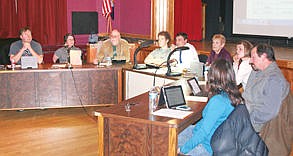Libby School District kitchen moving forward
After some setbacks, Libby school officials are moving ahead with a revised plan to build a kitchen facility that’s expected to result in long-term cost savings for the district.
“We are one of the few schools in Montana that do not operate a cooking kitchen,” said district superintendent Craig Barringer.
In the past, Libby schools have relied on a variety of contractors to provide breakfast and lunch for students at all grade levels. Finding vendors willing and able to provide the service has become difficult, in part because of stricter federal regulations governing school meal programs, Barringer said.
The district currently has just one contractor providing meals for students at the elementary school, while meals at the middle/high school are provided by district staff making do with less than ideal facilities. Around 500 students take part in the lunch program, with a smaller number for breakfast.
The small primary kitchen at the middle/high school, formerly used by a vendor under contract with the district, features two ovens in a cramped space, and dishes are washed in another small kitchen elsewhere in the building because of inadequate hot water service to the main kitchen, said district secretary Ellen Mills, who is a member of the committee working on the kitchen proposal.
“We have to wait for the hot water to get from the boilers to the kitchen, and that can take forever,” Mills said.
The district has two additional ovens – one in use at the elementary school and one in storage, never used – but currently lacks a place to put them. Bids were sought last summer for a project to expand the existing kitchen at the middle/high school.
“It was still going to be a tight spot, but it was going to be much better that what it is today,” Barringer said.
Only one contractor submitted a proposal, however, and costs were far above the $300,000 that had been budgeted.
“The bids came in about $200,000 more than we had projected, so at that point we had to go to plan B,” Barringer said. “We didn’t know what plan B was at that time.”
The committee began looking at other options, and the former library at the Asa Wood building stood out, with ample space and no need for tearing down walls or installing additional electrical power.
“We think those costs alone will save us money,” Barringer said.
“It’s basically just an empty shell right now,” Mills said.
Other advantages of the Asa Wood location include plenty of room for storage – the district currently stores some of its food supplies at the administration building – and easy access for deliveries, Barringer noted.
Barringer said he’s hopeful that if the district can get plans ready for the start of the construction season, interest from contractors will be higher and costs lower. The goal is to have a design prepared by April 1, allowing the project to go out for bid that month and construction to start in May, Barringer said.


